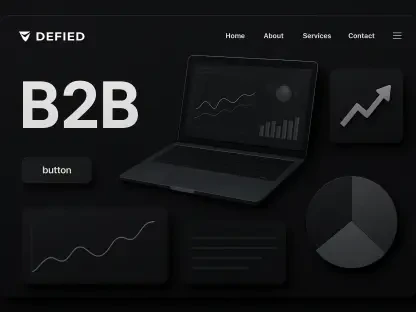In the fast-paced world of digital advertising, where every click and conversion counts, advertisers often grapple with a staggering statistic: over 80% of online ad spend is now influenced by automated systems. Google Ads Performance Max (PMax) campaigns stand at the forefront of this revolution, harnessing artificial intelligence to streamline ad delivery across multiple platforms. Yet, amidst this powerful automation, confusion persists about how to effectively guide these campaigns. This guide aims to demystify the intricate components of PMax, specifically audience signals and search themes, helping advertisers achieve optimized results by understanding their roles and limitations. By following this comprehensive roadmap, the mystery of collaborating with AI for superior ad performance will be unveiled.
Decoding the Power of Performance Max Campaigns
Performance Max campaigns represent a transformative leap in Google Ads, utilizing AI to deliver ads across Search, Display, Video, and other channels with a singular focus on conversion goals. Unlike traditional campaign types, PMax shifts the burden of optimization from manual inputs to machine learning, making it a cornerstone of modern digital advertising strategies. This automation allows for real-time adjustments, ensuring ads reach the most relevant audiences at the right moment, but it also demands a new mindset from advertisers accustomed to granular control.
The complexity surrounding audience signals and search themes often leaves advertisers puzzled, as these elements do not function as strict targeting tools. Many struggle to grasp why their carefully selected signals or themes may be overridden by the system. This guide addresses such uncertainties head-on, providing clarity on how to work alongside AI rather than against it, ultimately enhancing campaign outcomes.
Key insights from this exploration include the necessity of relinquishing old-school targeting tactics in favor of AI-driven decisions. By focusing on collaboration with the system through high-quality data inputs and robust creative assets, advertisers can unlock the full potential of PMax. The journey through these concepts will equip readers with actionable knowledge to navigate this innovative advertising landscape.
The Evolution of Advertising with PMax
The rise of Performance Max within the Google Ads ecosystem marks a significant departure from conventional advertising models. While traditional Search campaigns rely on keyword precision and Demand Gen focuses on demographic targeting, PMax prioritizes a goal-oriented framework. Introduced as a solution to streamline cross-channel advertising, it uses AI to dynamically adjust placements based on conversion likelihood, reshaping how campaigns are structured and managed.
This shift toward automation reflects a broader trend in digital marketing, where data-driven decisions increasingly overshadow manual interventions. PMax campaigns are designed to maximize results by analyzing vast datasets in real time, a capability far beyond human capacity. Advertisers must adapt to this model, recognizing that their role has evolved from direct control to providing strategic guidance through data and creative inputs.
Understanding audience signals and search themes becomes crucial in this context, as they form part of the dialogue between advertisers and AI. These elements are not just features but symbols of a larger movement toward machine learning dominance in advertising. Embracing this evolution means rethinking traditional metrics of success and aligning with AI priorities to stay competitive in an ever-changing digital environment.
Breaking Down Audience Signals and Search Themes in PMax
Navigating the nuances of PMax requires a clear comprehension of its core components, namely audience signals and search themes. These elements, often misunderstood as definitive targeting tools, serve as optional inputs that guide rather than dictate AI behavior. This section provides a structured breakdown, offering practical insights into their functionality and interaction with machine learning optimization.
By dissecting how these components operate, advertisers can avoid common pitfalls and align their strategies with AI capabilities. The following steps detail the purpose of each element, their limitations, and their integration into broader campaign goals. This clarity ensures that efforts are focused on areas of true impact within PMax.
The ultimate aim here is to foster an informed approach, where inputs are provided with purpose rather than assumption. Through a step-by-step exploration, the mystery surrounding these features dissipates, paving the way for more effective campaign management. Each subsection builds on this foundation, delivering actionable advice for optimal results.
Step 1 – Understanding Audience Signals as Guiding Inputs
Audience signals in PMax are not rigid targeting parameters but rather suggestions to steer the AI toward potential customer groups. Advertisers can input various data types, such as first-party data from customer lists or website visitors, Google-defined segments like in-market audiences, or custom segments based on specific interests. These inputs act as starting points for the AI to explore relevant audience pools.
The flexibility of these signals means they are not binding; they merely provide a directional hint. For instance, signaling an interest in tech enthusiasts might lead the AI to test related segments, but it retains the autonomy to pivot if other groups show higher engagement. This adaptability is a cornerstone of PMax, emphasizing performance over preset assumptions.
To maximize the utility of audience signals, advertisers should focus on providing high-quality, relevant data while understanding that the system may explore beyond these suggestions. This approach prevents frustration when expected audiences are not prioritized. Instead, it encourages a mindset of experimentation, allowing the AI to uncover unexpected opportunities.
The Flexibility of AI in Audience Selection
The AI’s ability to override audience signals is a defining feature of PMax, ensuring campaigns remain focused on conversion potential. For example, if a signal targets luxury shoppers but data reveals that value shoppers convert at a higher rate, the AI will shift focus accordingly. This dynamic adjustment highlights the system’s commitment to results over initial inputs.
Such flexibility can initially seem counterintuitive to advertisers used to strict targeting controls. However, it underscores the importance of trusting the AI to analyze performance metrics in real time. The system’s decisions are rooted in data, often identifying trends or segments that might be overlooked through manual analysis.
Recognizing this autonomy allows for a more collaborative approach, where signals are seen as conversation starters rather than commands. Advertisers should monitor performance reports to understand where the AI directs efforts, using these insights to refine future signals. This iterative process enhances campaign precision over time.
Step 2 – Grasping Search Themes as Directional Hints
Search themes in PMax differ fundamentally from keywords in traditional Search campaigns, functioning as optional guidance for relevant search queries rather than strict triggers. Advertisers can input themes to suggest areas of interest, such as specific product categories or competitor terms, helping the AI align ads with pertinent searches. These themes are particularly useful for new campaigns or product launches needing an initial focus.
Their role as hints means they do not guarantee ad placement for specific queries; the AI evaluates their relevance based on conversion performance. If a theme proves ineffective, it is sidelined in favor of queries more likely to drive results. This ensures that ad spend remains aligned with campaign objectives, regardless of initial suggestions.
Practical applications of search themes include supporting niche markets or capturing competitor traffic, but they should be used judiciously. Advertisers must recognize that these inputs are supplementary, designed to assist rather than control. A balanced approach, where themes complement other campaign elements, yields the best outcomes.
Avoiding Over-Reliance on Search Themes
A common misstep in PMax management is placing excessive trust in search themes to dictate campaign direction. Since the AI prioritizes conversion-focused queries, irrelevant or underperforming themes are often disregarded. This can lead to wasted effort if too much emphasis is placed on crafting extensive theme lists without regard for performance data.
Instead, advertisers should view search themes as a supportive tool, not a primary driver. Monitoring campaign reports to see which queries actually trigger ads provides valuable feedback on theme effectiveness. This data-driven perspective ensures that resources are not squandered on inputs the AI deems unhelpful.
The lesson here is to maintain realistic expectations about search themes, using them as a starting point while allowing the AI to refine focus. This prevents frustration when themes are ignored and fosters a mindset of adaptability. By focusing on broader campaign goals, advertisers can better align with AI priorities.
Step 3 – Identifying True Drivers of PMax Success
While audience signals and search themes offer guidance, the true controls in PMax campaigns lie elsewhere, in elements like conversion tracking, bid strategies, and creative assets. These components directly influence how the AI optimizes ad delivery and targeting, shaping performance far more than suggestive inputs. Understanding their impact is critical for effective campaign management.
Conversion tracking acts as the foundation, ensuring the AI measures meaningful actions and directs ads to relevant audiences. Bid strategies, such as Maximize Conversions or Target CPA, align efforts with business goals, while creative assets determine user engagement. Together, these elements form the backbone of PMax success, far outweighing the influence of signals or themes.
To harness these drivers, advertisers must prioritize accuracy and quality in setup. Robust data collection, strategic bidding choices, and compelling ad content create a synergy that propels campaigns forward. This focus shifts attention from peripheral inputs to core mechanisms, ensuring resources are allocated where they matter most.
Prioritizing Conversion Tracking as the AI Compass
Accurate conversion tracking serves as the guiding compass for PMax campaigns, directing the AI toward placements that yield desired outcomes. Without precise tracking of actions like purchases or sign-ups, the system cannot effectively optimize ad delivery. Setting up comprehensive tracking mechanisms is therefore non-negotiable for success.
This element ensures that every ad impression is evaluated based on meaningful metrics, allowing the AI to identify high-value audiences and queries. Errors or gaps in tracking can lead to misguided optimization, wasting budget on irrelevant placements. Regular audits of tracking setups help maintain data integrity, supporting AI decisions.
Advertisers should invest time in defining key conversions aligned with business objectives, ensuring the AI has a clear target. This clarity transforms raw data into actionable insights, steering campaigns toward maximum impact. A well-configured tracking system is the bedrock of any successful PMax strategy.
Leveraging Smart Bidding for Efficiency
Smart Bidding strategies, such as Maximize Conversions or Target CPA/ROAS, are integral to PMax, aligning ad spend with specific business goals. These automated options rely on robust conversion data to optimize for either volume or efficiency, adjusting bids in real time to capture high-value opportunities. Their effectiveness hinges on the quality of input data.
Choosing the right bid strategy requires a clear understanding of campaign priorities, whether maximizing reach or maintaining profitability. For instance, Target ROAS focuses on return on ad spend, ideal for revenue-driven goals, while Maximize Conversions suits volume-focused objectives. Tailoring strategies to these needs enhances overall efficiency.
To fully leverage Smart Bidding, advertisers must ensure consistent data flow through accurate tracking, allowing the AI to refine bids dynamically. Periodic reviews of performance metrics help adjust strategies as market conditions shift. This proactive approach keeps campaigns aligned with evolving business landscapes.
Key Takeaways for Mastering PMax Campaigns
This section distills the critical insights into a concise reference list for advertisers navigating Performance Max campaigns:
- PMax emphasizes AI-driven, goal-based optimization over manual targeting controls.
- Audience signals and search themes function as suggestions, not definitive parameters for ad placement.
- Conversion tracking, bid strategies, and creative assets are the primary influencers of campaign performance.
- Duplicating asset groups with identical creatives but different signals should be avoided to prevent budget waste and fragmented AI learning.
Applying PMax Insights to Broader Advertising Strategies
The principles underlying PMax campaigns extend beyond Google Ads, reflecting a growing reliance on automation and machine learning across digital marketing. These campaigns highlight the importance of adapting to real-time data, a skill applicable to other platforms where AI plays a significant role. By embracing data-driven optimization, advertisers can enhance strategies across diverse channels, ensuring agility in dynamic markets.
Balancing creative input with AI autonomy presents a recurring challenge, as does maintaining data accuracy amidst evolving consumer behaviors. Lessons from PMax, such as prioritizing core metrics over suggestive inputs, offer a blueprint for tackling these issues. Applying these insights fosters a cohesive approach, where automation complements human strategy rather than competes with it.
Continuous monitoring emerges as a vital practice, allowing advertisers to refine campaigns based on performance trends. This proactive stance prepares for future AI-driven developments, ensuring strategies remain relevant as technology advances. By integrating PMax learnings into broader efforts, a foundation for sustained advertising success is built.
Final Thoughts and Next Steps for PMax Success
Reflecting on the journey through Performance Max campaigns, it becomes evident that adapting to an AI-driven framework demands a shift in perspective, focusing on core elements like conversion tracking and creative quality rather than overemphasizing signals and themes. This exploration clarifies how true collaboration with AI unlocks superior ad performance, reshaping traditional approaches to campaign management. The process underscores the value of flexibility, as the system often reveals unexpected opportunities beyond initial inputs.
Looking ahead, advertisers are encouraged to dive deeper into experimentation with PMax, testing varied creative assets and bid strategies to uncover unique performance drivers. Regular audits of conversion data ensure the AI operates with precision, while exploring advanced reporting tools offers insights into optimization patterns. These steps promise to refine strategies further, cementing a partnership with technology for long-term advertising success.
As a final consideration, integrating PMax insights with emerging AI tools across platforms positions advertisers to stay ahead of industry trends. This forward-thinking approach, grounded in data accuracy and adaptability, paves the way for navigating future complexities in digital marketing. The path forward lies in continuous learning, leveraging every campaign as a stepping stone toward mastery of automated advertising.









